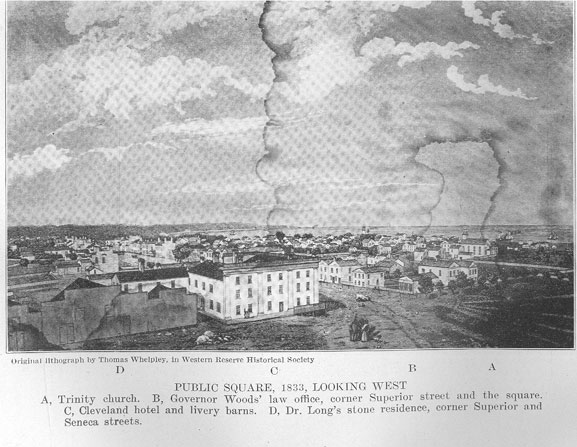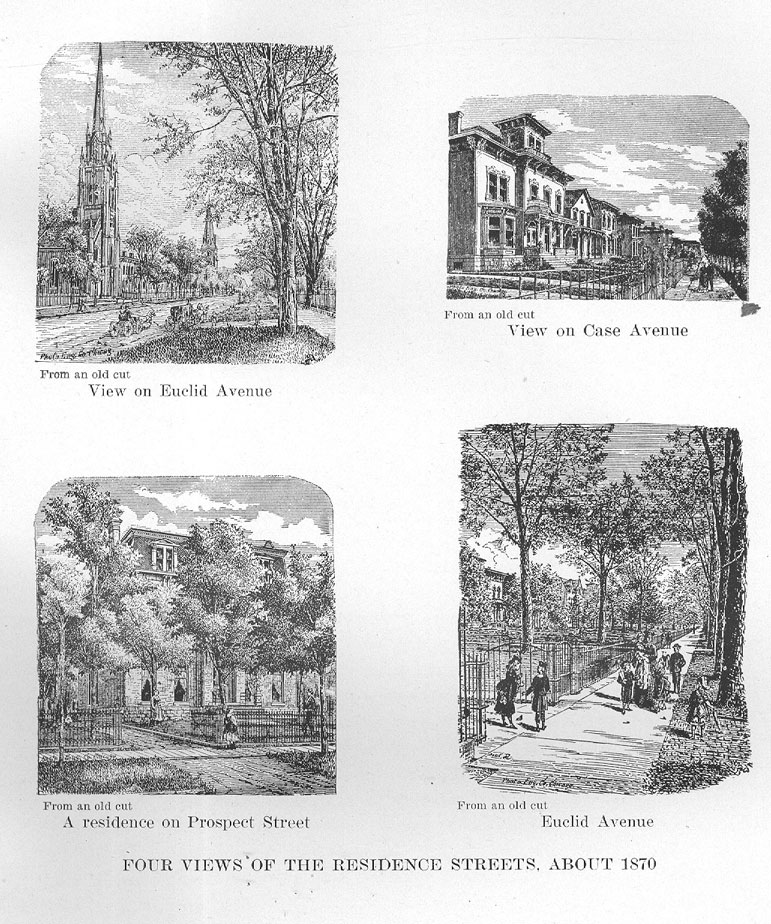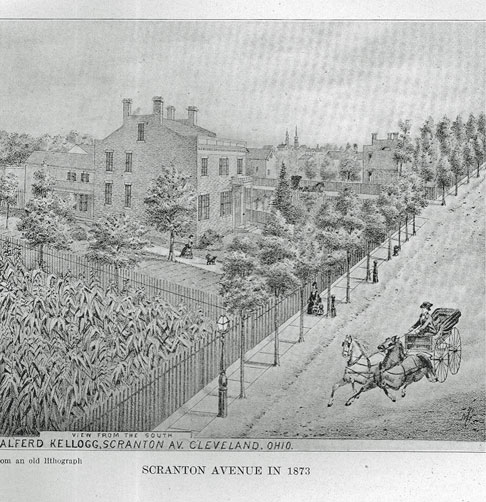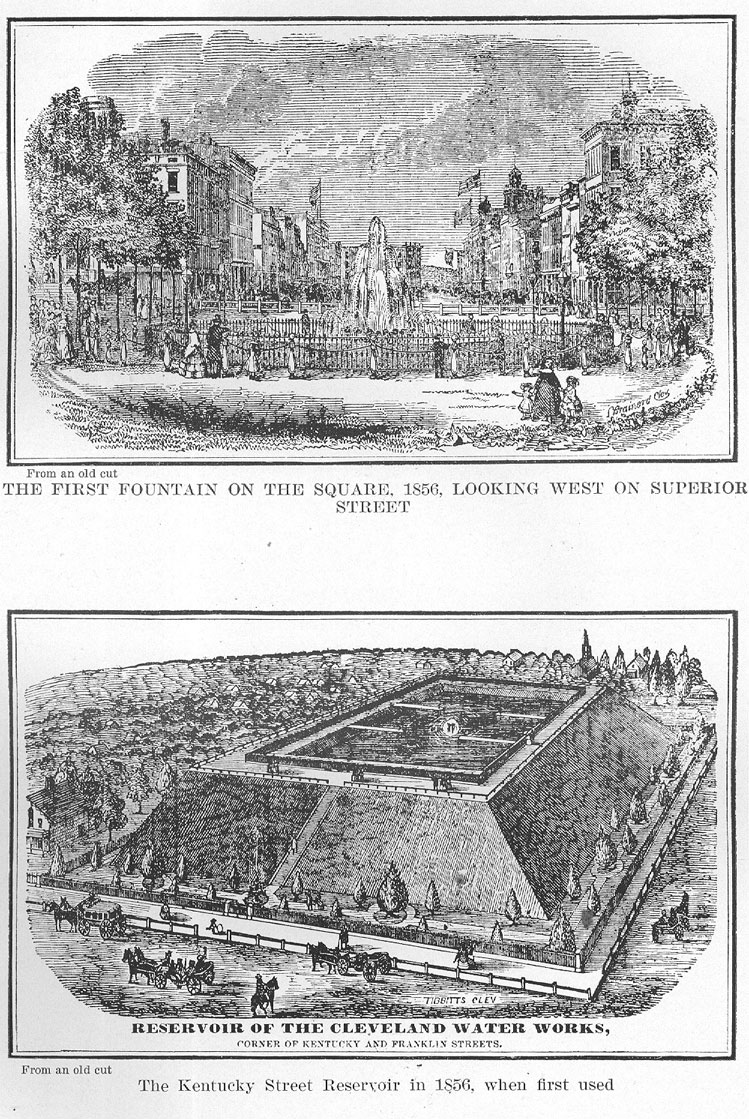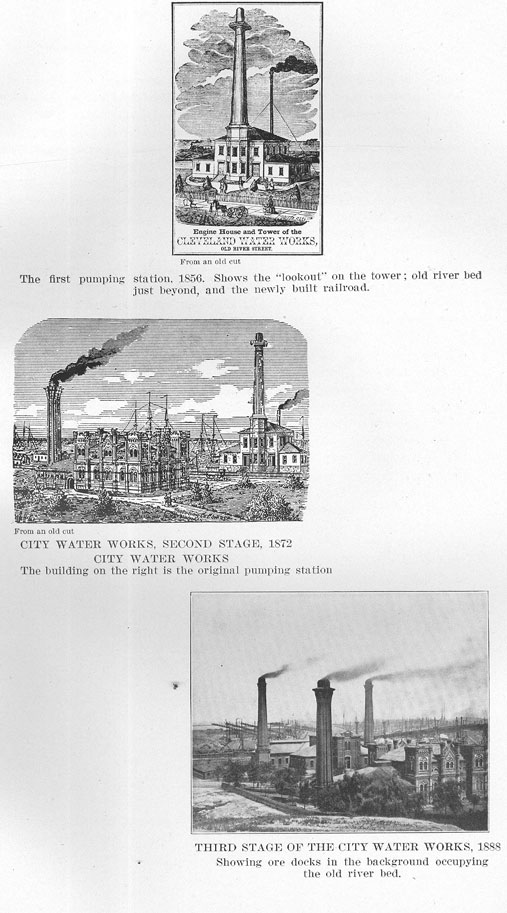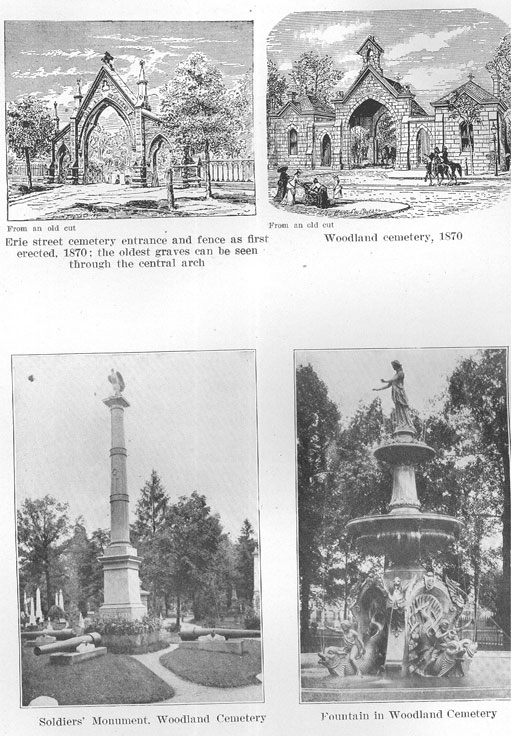100 - HISTORY OF CLEVELAND
built a substantial house. He and his sons were engaged in river traffic for a number of years. He died February 8, 1814, aged only forty-seven years. "He was kind and generous to the poor and unfortunate, hospitable to the stranger, would put himself to great inconvenience to oblige a neighbor, and was always at the service of an individual or the public, when a wrong had been perpetrated. In all the domestic relations he was kind and affectionate." (3)
Elijah Gun, who also arrived in 1797, was for many years the picturesque boatman who ferried the stranger across the Cuyahoga river at the foot of Superior street.
In 1798 arrived two other men who were potent in laying the foundation of our city. Nathaniel Doan (sometimes spelled Doane), was a member of the first surveying party and also of the second. He was so confident of the future of the western country that he brought his family in 1798, consisting of his wife Sarah and four children. He moved into the cabin that had been occupied by Job Stiles and conducted a blacksmith shop, the first in the village, on the south side of Superior street just east of Bank street. In 1799 he moved four miles to the eastward where Doan's Corners commemorate the location of his farm, There he soon established a smithy. He was not only a useful blacksmith, however, but a most useful citizen of the county. He kept a tavern and a store, built a little saleratus factory on his farm, was postmaster and justice of the peace, and in the absence of clergymen, conducted religious services in his own home.
The second pioneer to arrive in 1798, who impressed his personality upon our city, was Samuel Dodge. As Nathaniel Doan was Cleveland's first blacksmith, Samuel Dodge was Cleveland's first carpenter. He was twenty-one years of age and unmarried when he came to our community, had a fair education and was endowed with great energy and good sense. A carpenter is a very useful member of a pioneer community and Samuel Dodge's services were indispensable. He built in 1801 the first frame barn erected in Cleveland, for Samuel Huntington. Tradition has it he received three hundred and thirty dollars as a consideration, and that he took in lieu of cash several ten acre lots located between Euclid avenue and St. Clair street. Dodge street (now 17th) indicates the location of this ' fortunate bargain. He married the daughter of Nathaniel Doan and built for himself a log but on the land he had received from Governor Huntington, and there he dug a well on the north side of Euclid avenue near the present location of Dodge street. This was the first well dug in the village. It was lined with small boulders, was covered with a stone slab and provided with a sweep, common in the backwoods. It did samaritan service for many years.*
These four men, Lorenzo Carter, James Kingsbury, Nathaniel Doan and Samuel Dodge, deserve t0 be remembered aS the actual founders of the village of Cleveland, for Moses Cleaveland never returned after his first furtive visit to the
3 - "Early History of Cleveland," p. 347.
* "December r4, 1804, Mr. Huntington deeded to Mr. Dodge, for the consideration of three hundred and thirty dollars as named in conveyance, eleven ten-acre lots embracing a strip of land extending from what was called in this deed, the "Middle Road," oftened called "Central High*ay," now Euclid avenue, to the lake. * * * Some of this land is still held in the Dodge family. * * * It is said the abstracts of title to this land show the fewest transfers generally—three in all—of any real estate in Cuyahoga county." —O. J. Hodge, "Annals Early Settlers' Association," Vol. V. p. 348.
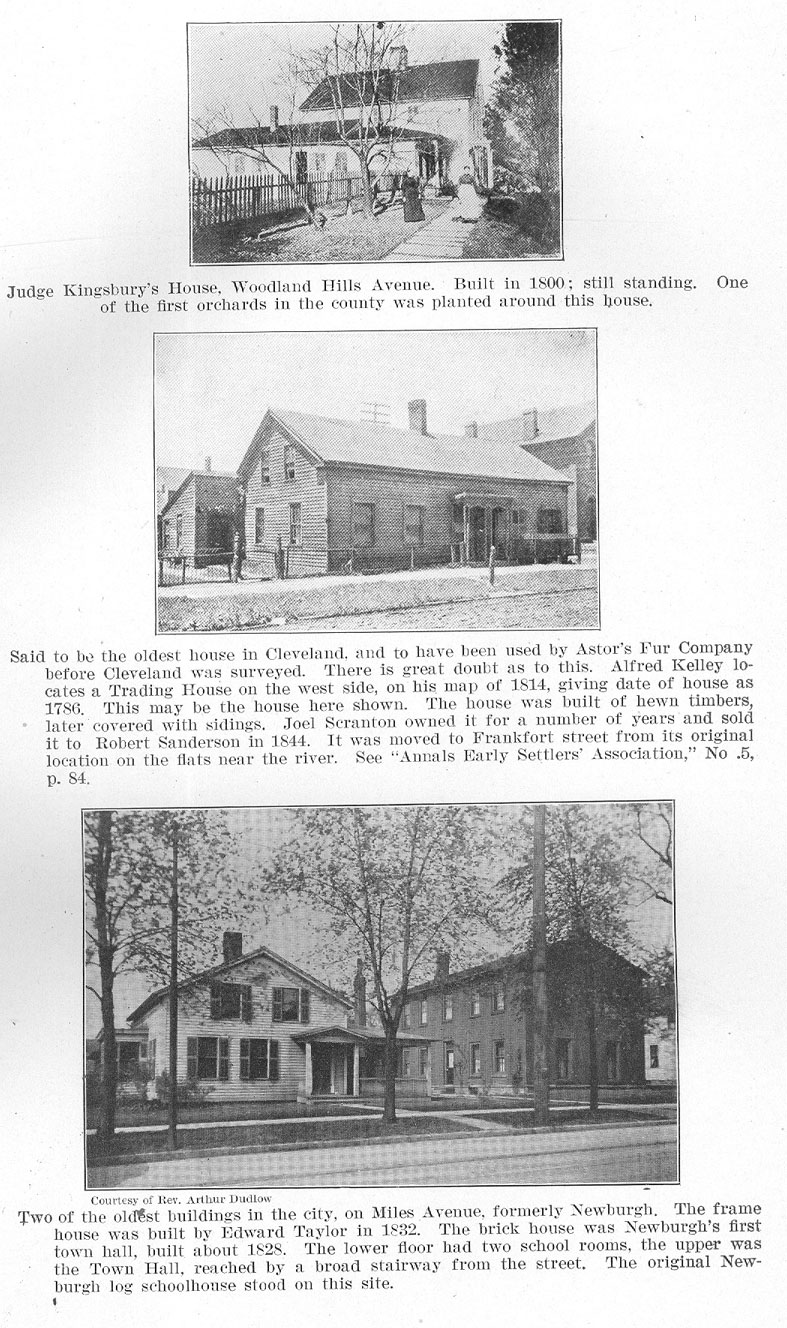
HISTORY OF CLEVELAND - 101
wilderness. But these men endured the privations and vicissitudes of frontier life, reared their families here and plied their honest trades. Their foresight, energy, good sense, and high ideals of civic duty established the village that developed into the metropolis of a great state. Their neglected graves are tokens of the carelessness and ingratitude of our citizenship. Three of them, Samuel Dodge, Lorenzo Carter and James Kingsbury, were buried in the old Erie cemetery ; Nathaniel Doan is buried in the East Cleveland cemetery. No public monument commemorates their arduous services.
Among the arrivals of 1800 was Amos Spafford, one of the members of the first surveying party. He lived here but a few years when he removed to the Miami river. He was active in the War of r812. The condition of the ridge between Doan's Corners and Newburgh, which was more populous than Cleveland in 1806, is set forth by Judge Walworth, who then a boy of sixteen, came to visit the family of W. W. Williams. "Newburgh street was opened previously from the mill north to Doan's Corners, and was then lined with cultivated fields on both sides, nearly the whole distance from Judge Kingsbury's to the mill. But much dead timber remained in the fields. .There were some orchards of apple trees on some of the farms and Judge Kingsbury's orchard bore a few apples that season, which was probably the first season of bearing." (4)
In 1800, also came Alexander Campbell, one of the earliest traders to bring a permanent stock of goods to the village ; and David Bryant, whose distillery near the spring at the foot of Superior street, proved very popular with the Indians and useful to the pioneers. In 1801 came Samuel Huntington, who is mentioned in another chapter, and Timothy Doan, brother of Nathaniel Doan, who, like his brother, became a useful member of the community. He purchased a section of land for about a dollar an acre near Doan's Corners, where he remained during the rest of his life. (5)
In 1806 two important additions to the pioneer colony were made when Nathan Perry and John Walworth arrived. Nathan Perry was called by Judge Cleveland "the first great pioneer merchant of Cleveland." He was a successful trader with the Indians, was born in Connecticut in 1760, came to Ohio in 1796, brought his family here in 1806, purchased a thousand acres of land in what is now Lake county for about fifty cents an acre and became the owner of a five acre tract in Cleveland between Superior, St. Clair, Water and Banks streets, and of a tract of land afterwards known as the Horace Perry farm near the intersection of Broadway and Perry street. At the corner of Superior and Water street he built a storehouse and dwelling, which was replaced within a few years by a brick store. His business expanded until he became one of the leading business men in northern Ohio, and one of the wealthiest men of the city. He died June 24, r865. His only child became the wife of Senator Henry B. Payne.
John Walworth came to Painesville in 1800. He moved to Cleveland in r806 and died on the l0th of September, 1812, leaving three sons, John P., Horace and Ashbel W., all of whom became potent in our community, and two daughters, who were Mrs. Dr. Long and Mrs. Dr. Strickland. He was an active man, kind
4 - "Early History of Cleveland," p. 428.
5 - For details of the Doan family, see "Sketch of the Doan Family," by John Doan, "Annals of Early Settlers Association" No. 6, p. 51.
102 - HISTORY OF CLEVELAND
and intelligent, favored by the Indians and popular with all. He held more offices than any other of the early settlers. Governor St. Clair commissioned him as justice of the peace in July, 1802 ; Governor Tiffin appointed him as associate judge in April, 1803 ; he was appointed postmaster of Painesville in November, 1804; inspector of the port of Cuyahoga, June 12, 1805; collector of the district of Erie, July 17, 1806; associate judge of Cuyahoga county, January 23, 1806; postmaster of Cleveland in May, 1806, which latter office he held until the time of his death. He was also recorder and clerk of the common pleas court of Cuyahoga county. During the War of 1812 his courage, vigilance and energy did much to dispel the panic among the villagers on the news of Hull's surrender.
In 1808 Abram Hickox became a member of the community. He built his first blacksmith shop near the corner of Superior and Bond, where his sign "Uncle Abram works here," swung over the street for many years. Later he moved his smithy to the corner of Euclid and Hickox street. He was a kind-hearted man as well as a very useful one, and his quaint figure was well known to all of the pioneers. He died in r845, and was buried in the Erie street cemetery.
In 1808 Doan's Corners received two valuable additions when Samuel Cozad and his brother Elias settled there. They built the first tannery in that neighborhood. Stanley Griswold was another fortunate addition to the village in this year. He had been appointed secretary of the territory of Michigan' in 1805, but removed to Doansis Corners soon afterward, where he was made town clerk and soon thereafter was appointed United States senator by Governor Huntington, to fill out an unexpired term.
In 1809 arrived a man who became one of the pioneers in lake traffic and shipbuilding. This was Levi Johnson. He was a native of Herkimer county, New York, and was about twenty-four years old when he came to Cleveland. He built a log cabin on Euclid road near the public square. He was a builder and carpenter ; many of the more pretentious houses of the town were his handiwork. In 1814 he built the schooner, "Lady's Master." It was built "upon the hill" and hauled to the river by ox teams. Subsequently he built quite a number of these early trading boats. He built the first stone lighthouse here, also the lighthouse at Cedar Point and Sandusky bay, as well as a considerable portion of the first government pier. His brothers, Samuel and Jonathan joined in these various enterprises.
1810 was an important year to the early settlement, for it welcomed its first lawyer and first doctor. The first lawyer was Alfred Kelley. He was born in Middletown, Connecticut, November 7, 1789, attended Fairfield academy, came to Cleveland on horseback in company with Dr. Jared P. Kirtland and Joshua Stow, two men who afterwards became distinguished in the development of the Western Reserve. Samuel Huntington, who lived in Cleveland before 1810, was a lawyer, but he did not practice here and remained only a few years. Alfred Kelley was Cleveland's first actual lawyer. His strong personality and active mind are impressed upon all of the early village legislation. He became a member of the general assembly, and served almost continuously from r814 until 1822. He left the stamp of his activity upon many state laws, especially the canal and banking laws. In 1822 he was appointed canal commissioner of the state. He removed to Columbus in 1830, and died there December 2, 1859.

HISTORY OF CLEVELAND - 103
Dr. David Long, Cleveland's first physician, also came here from New York, from Washington county. He was educated in New York city and when he joined with lawyer Kelley in a litttle office on Superior street, there was no physician nearer than Painesville, Hudson, Wooster and Monroe. Dr. Long at once became an active public-spirited member of the new community.* Elias and Harvey Murray, merchants, also arrived in 1810. They built a frame store on Superior street, west of the Forest City block. Samuel Williamson and his brother Matthew were important arrivals in 1810. They built the first tannery in the village of Cleveland. Samuel died in 1834. His son Samuel became one of the distinguished members of the Cleveland bar and served in many public positions. He was for many years the president of the Society for Savings and died in 1884. And he in turn left to the county a distinguished son, Samuel E. Williamson, noted jurist and friend of all good works, who died February 21, 1903.
Mr. Y. L. Morgan has left the following description of the town in 1811:
"The following to the best of my recollection are the names of men who lived in what was then Cleveland in the fall of 1811 and the spring of 1812. Possibly a few names may be missing. I will begin north of the Kingsbury creek on Broadway. The first was Major Samuel Jones on the hill near the turn of the road. Farther down came Judge John Walworth, then postmaster, and his oldest son, A. W. Walworth, and son-in-law, Dr. David Long. Then on the corner where the Forest City House now stands, was a Mr. Morey. The next was near the now American House, where the little postoffice then stood, occupied by Mr. Hanchet, who has just started a little store. Close by was a tavern kept by Mr. George Wallace. On the top of the hill north of Main street, Lorenzo Carter and son, Lorenzo, Jr., who kept tavern also. The only house below on Water street was owned by Judge Samuel Williamson, with his family and his brother Matthew, who had a tannery on the side hill below. On the corner of Water and Superior streets was Nathan Perry's store, and his brother, Horace Perry, lived near by. Levi Johnson came to Cleveland about that time, likewise two brothers of his who came soon after —Benjamin, a one legged man, and I think the other's name was John. The first and last were lake captains for a time. Abraham Hickox, the old blacksmith ; Alfred Kelley, Esq., who traded with 'Squire Walworth at that time ; then a Mr. Bailey, also Elias and Harvey Murray, and perhaps a very few others in the town, not named. On what is now Euclid avenue from Monumental Square through the woods to East Cleveland, was but one man, Nathan Chapman, who lived in a small shanty, with a small clearing around him and near the present Euclid Station. He died soon after. Then at what was called Doan's Corners, lived two families only, Nathaniel, the older, and Major Seth Doan. Then on the south, now Woodland Hills avenue, first came Richard Blin, Rodolphus Edwards and Mr. Stephens, a school teacher ; Mr. Honey, James Kingsbury, David Burras, Eben Hosmer, John Wightman, William W. Williams and three sons, Frederick, William W., Jr, and Joseph. Next on the Carter place, Philomen Baldwin and four sons, Philomen, Jr., Amos, Caleb and Runa. Next James Hamilton; then Samuel Hamilton (who was drowned in the lake), his widow and three
* See "Pioneer Medicine on the Reserve," by Dudley P. Allen, M. D., Magazine Western History, Vol. III, p. 286.
104 - HISTORY OF CLEVELAND
sons, Chester Justice and Samuel, Jr. In what was called Newburg and now Cleveland, six by the name of Miles—Erastus, Theodore, Charles, Samuel, Thompson and Daniel; widow White with five sons, John, William, Solomon, Samuel and Lyman ; a Mr. Barnes ; Henry Edwards ; Allen Gaylord and father and mother. In the spring of 1812, came Noble Bates, Ephraim and Jedediah Hubbel with their aged father and mother (the latter soon after died). In each family were several sons ; Steven Gilbert, Sylvester Burk with six sons, B. B. Burk, Gaius, Erectus, etc.; Abner Cochran on what is now called Aetna street. Samuel S. Baldwin, Esq., was sheriff and county surveyor and hung the noted Indian, John O'Mic, in r812; next Y. L. Morgan with three sons, Y. L., Jr., Caleb and Isham A. The next on the present Broadway, Dyer Sherman, Christopher Gunn, Elijah, Charles and Elijah Gunn, Jr., Robert Fulton, Robert Carr, Samuel Dille, Ira Ensign, Ezekiel Holly and two sons, Lorin and Alphonzo, Widow Clark and four sons, Mason, Martin, James and Rufus." (6)
May 10, 1813, Captain Sholes came into the town with his company of soldiers. He describes the village as follows : "I halted my company between Major Carter's and Wallace's. I was here met by Governor Meigs, who gave me a most cordial welcome, as did all the citizens. The governor took me to a place where my company could pitch their tents. I found no place of defense, no hospital and a forest of large timber (mostly chestnut), between the lake and the lake road. There was a road that turned off between Mr. Perry's and Major Carter's that went to the town, which was the only place that the lake could be seen from the buildings. This little cluster of buildings was all of wood, I think none painted. There were a few houses back from the lake .road. The widow Walworth kept the postoffice, or Ashbel, her son. Mr. L. Johnson, Judge Kingsbury, Major Carter, Nathan Perry, George Wallace and a few others were there. At my arrival I found a number of sick and wounded, who were of Hull's surrender sent here form Detroit, and more coming. These were crowded into a log cabin and no one to care for them. I sent one or two of my soldiers to take care of them, as they had no friends. I had two or three good carpenters in my company and set them to work to build a hospital. I very soon got up a good one, thirty by twenty feet, smoothly and tightly covered and floored with chestnut bark, with two tier of bunks around the walls with doors and windows and not a nail, a screw or iron latch or hinge about the building. Its cost to the government was a few extra rations. In a short time I had all the bunks well strawed and the sick and wounded good and clean, to their great joy and comfort, but some had fallen asleep. I next went to work and built a small fort about fifty yards from the bank of the lake in the forest. This fort finished, I set the men to work to fell the timber along and near the bank of the lake, rolling the logs and brush near the brink of the bank to serve as a breastwork. On the 19th of June, a part of the British fleet appeared off our harbor, with the apparent design to land. When they got within one and a half miles of our harbor, it became a perfect calm, and they lay there till afternoon when a most terrible thunderstorm came up and drove them from our coast. We saw them no more as enemies. Their object was to destroy the
6 - "Annals of Early Settlers Association," No. 3, p. 67.
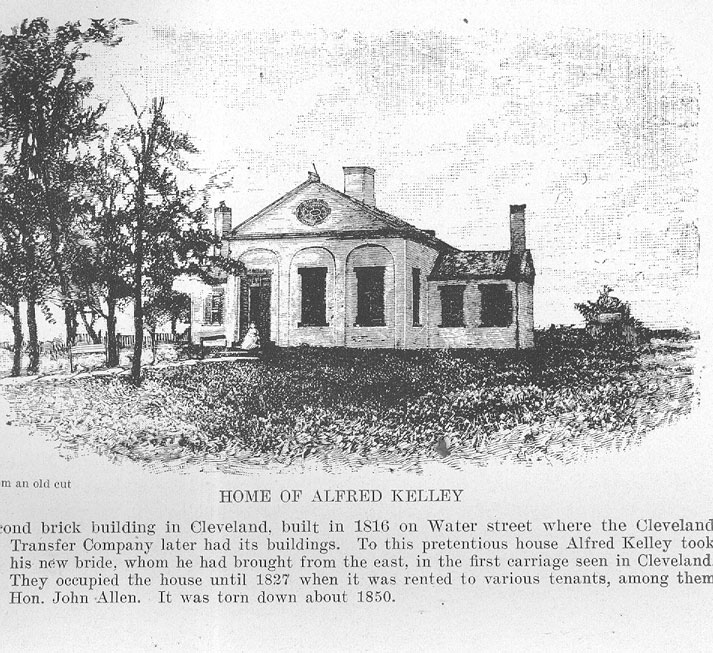
HISTORY OF CLEVELAND - 105
public or government boats then built and building in the Cuyahoga river and other government stores at that place." (7)
The war of 1812 seems to have had a blighting effect upon our village. Very few arrivals occurred until about r816, when Noble H. Merwin came. He purchased the tavern of George Wallace on the corner of Superior street and Vineyard lane, later called South Water street, and also a parcel of land on Division street, later called Center street. His tavern was soon called the Mansion house.
R. T. Lyon states that Mr. Merwin came to Cleveland in 1815. His family, however, did not arrive until 1876. In his little tavern Mr. Merwin entertained many of the distinguished men of the day. He was later interested in the forwarding and commission business and held many offices of public trust In 1816 Leonard Case arrived. His accession to the community was invaluable (a sketch of Mr. Case is found in the chapter on the Case School of Applied Science).
Captain Lewis Dibble gives this description of the town in 1816:
"On leaving Doan's Corners one would come in a little time to a cleared farm. Then down about where A. P. Winslow now lives [Euclid avenue and Giddings street], a man named Curtis had a tannery. There was only a small clearing, large enough for the tannery and a residence. The brook that crossed the road there was called Curtis brook. There was nothing else but woods until Willson avenue was reached and there a man named Bartlett had a small clearing, on which was a frame house, the boards running up and down. Following down the line on what is now Euclid avenue, the next sign of civilization was found at what is now Erie street, where a little patch of three or four acres had been cleared, surrounded by a rail fence. Where the Methodist church now stands, corner Euclid and Erie streets [Cleveland Trust Company], a man named Smith lived in a log house. I don't remember any building between that and the Square, which was already laid out, but covered with bushes and stumps." (8)
In 1818, Ahaz Merchant arrived. He was born in Connecticut, March 21, 7794. He was county surveyor from 1833 to 1835 and from r845 to 1850. Much of the early engineering work in the city and county was done by him. All of the old streets were resurveyed by him and he established their grades. And he platted the early city allotments on both sides of the river. He died March 28, 1862.
In 1818, Reuben Wood, who afterward became governor of Ohio, and Orlando Cutter, who brought with him a stock of goods valued at twenty thousand dollars, a very large amount for that time, and Samuel Cowles, settled here. The Cowles family has indelibly impressed itself upon the community. Levi Sargent brought his family to Cleveland in 1818. His son John H. Sargent, became one of the foremost men in railroad building and other extensive engineering works in Ohio. John was a lad when he came to Cleveland
7 - Whittlesey’s "Early History of Cleveland," p. 442, quoted from a letter to John Barr, dated July, 1858.
8 - "Annals Early Settlers Association," No. 7, P. 54.
106 - HISTORY OF CLEVELAND
and has left a description of the town as it appeared some years later. "Orlando Cutter dealt out groceries and provisions at the top of Superior lane. I can still remember the sweets from his mococks of Indian sugar. Nathan Perry sold dry goods, Walworth made hats and Tewell repaired old watches on Superior street. Dr. Long dealt out ague cures from a little frame house nearly opposite Banks street at first but not long after from a stone house that stood a little back from Superior street. The 'Ox Bow Cleveland Center' was then a densely wooded swamp. Lorenzo Carter lived on the west side of the river, opposite the foot of Superior lane. He was a great hunter ; with his hounds he would drive the deer onto the sand spit between the lake and the old river bed, where they would take to the water, when Carter's unerring aim would convert them into venison." (9)
Asa Sprague, came in April, 1818. He says :
"I arrived a few weeks after the first census had been taken. Its population was at that time but one hundred and seventy-two souls ; all poor and struggling hard to keep soul and body together. Small change was very scarce. They used what were called 'corporation shin plasters' as a substitute. The inhabitants were mostly New England people and seemed to be living in a wilderness of scrub oaks. Only thirty or forty acres had been cleared. Most of the occupied town lots were fenced with rails. There were three warehouses on the river ; however very little commercial business was done as there was no harbor at that time. All freight and passengers were landed on the beach by lighter and small boats. To get freight to the warehouses, which were a quarter of a mile from the beach, we had to roll it over the sand and load it int0 canal boats. The price of freight from Buffalo to Cleveland was a dollar a barrel, the price of passage on vessels ten dollars, on steamboats, twenty dollars." (10)
In 1819, picturesque Joel Scranton arrived in the little village. His energy and common sense soon made him one of the leading men of the place. He ̊ brought with him a schooner load of leather, which formed the basis of his trading and of his fortune. He purchased the flats on the west side of the river and they were known for many years as "Scranton flats." The leading street through them is still known by his name. John Blair came here from Maryland in 1819. He had three dollars in his pocket, began to speculate in pork and soon developed into a large produce and commission merchant on the river. In r820 came Peter Weddell, one of the leading factors in the commercial life of the town, engaging in the trading business on the lake and later on the canal. The Weddell house was built by him.
John Willey arrived in 1822. He was the first mayor of the city of Cleveland, was for a number of terms a member of the house of representatives and of the senate, and served as judge on the bench of common pleas. His clearness of mind was of great service to the young community and to the newly made municipality.
Richard Hilliard came in r823 from New York and engaged m the mercantile business. His place was located on Superior street where the old Atwater build-
9 - "Annals Early Settlers Association," No. 6, p. 12.
10 - "Annals Early Settlers Association," No. 2, p. 74.
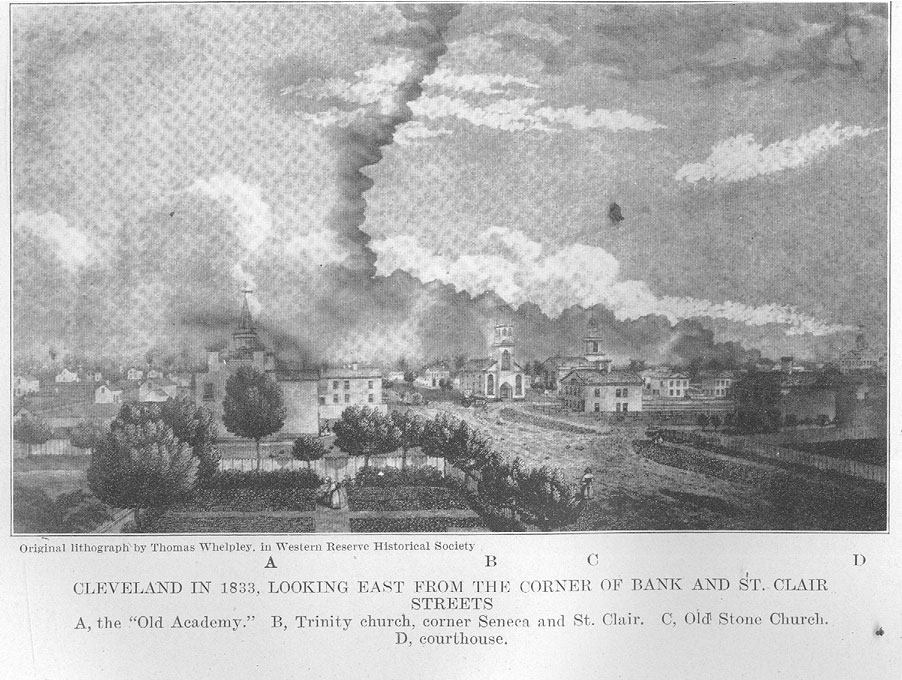
HISTORY OF CLEVELAND - 107
ing stood. He soon had one of the leading dry goods and grocery establishments in the county. He formed a partnership with William Hayes under the firm name of Hilliard & Hayes. Later on he built a brick block on the corner of Water and Frankfort streets. He organized a company with Courtland Palmer of New York and Edwin Clark of Cleveland for engaging in the manufacturing business on the flats. He was later a promoter of railroads and other extensive enterprises. He died December 21, 1856.
In 1824 Harvey Rice, a schoolteacher, came to Cleveland. He was twenty- four years of age, a graduate of Williams college, one of the first college graduates to reach the town. He died in r891. A monument erected to his memory stands in Wade park. He was the father of the Ohio state school law, one of the founders of the Cleveland public schools, a legislator of eminence and a writer of pleasing grace. He has left for us a description of the town at the time of his arrival, on the 24th of September, 1824. "A sand bar prevented the schooner from entering the river. The jolly boat was let down and two jolly fellows, one from Baltimore, and myself, were transferred to the boat with our baggage, and rowed by a brawny sailor over the sand bar into the placid waters of the river and landed on the end of a row of planks that stood on stilts and bridged the marshy brink of the river to the foot of Union lane. Here we were left standing with our trunks on the wharf end of a plank at midnight, strangers in a strange land. We hardly knew what to do but soon concluded that we must make our way in the world, however dark the prospect. There was no time to be lost, so we commenced our career in Ohio as porters by shouldering our trunks and groping our way up Union lane to Superior street, where we espied a light at some distance up the street, to which we directed our footsteps.
"In the morning I took a stroll to see the town and in less than half an hour Aaw all there was of it. The town even at that time was proud of itself and called itself the 'gem of the West.' In fact the Public Square was begemmed with stumps, while near its center glowed its crowning jewel, a log courthouse. The eastern border of the Square was skirted by the native forest which abounded in rabbits and squirrels and afforded the villagers a 'happy hunting ground.' The entire population did not at that time exceed four hundred souls. The dwellings were generally small but were interspersed here and there with pretentious mansions." (11)
Judge Rufus P. Spaulding, eminent in the public annals of our state and a diAtinguished member of the Cuyahoga county bar, has this to say of his first visit to Cleveland :
"In the month of March, 1823, I first saw Cleveland. I came from Warren in Trumbull county, where I then lived, in company of Hon. George Tod, who was then President Judge of the third Judicial Circuit, which embraced, if I mistake not, the whole Western Reserve. We made the journey on horseback and were nearly two days in accomplishing it. I recollect the judge, instead of an overcoat, wore an Indian blanket drawn over his head by means of a hole cut in the center. We came to attend court and put up at the house of Mr. Merwin, where we met quite a number of lawyers from adjacent counties. At this time the village of Warren where I lived was considered altogether ahead of Cleveland in impor-
11 - "Annals Early Settlers Association," Vol. 3, p. 35.
108 - HISTORY OF CLEVELAND
tance; indeed there was very little of Cleveland at that day east or southeast of the Public Square. The population was estimated at four hundred souls. The earliest burying ground was at the present intersection of Prospect and Ontario streets. Some years afterward, in riding away from Cleveland in the stage coach, I passed the Erie Street Cemetery just then laid out. I recollect it excited my surprise that a site for a burying ground should be selected so far out of town." (12)
In 1825 arrived John W. Allen from Litchfield, Connecticut. He studied law here with Judge Samuel Cowles, was elected president of the village from 1831 to 1835 and mayor of the city in 1841. In 1835 he was a member of the Ohio senate and in 1836 was sent to congress from this district, serving two terms, became postmaster in 187o, reappointed in 1874, was one of the first bank commissioners of the state of Ohio and active in building the first railroads. He was a gentleman of great refinement and dignity of bearing, untiring in his efforts to develop the city. He died October 5, 1887.
Another distinguished arrival at that time was Sherlock J. Andrews, who came here from Wallingford, Connecticut, where he was born in 1801. He was graduated from Union college and educated for the bar. In 1825 he formed a partnership with Samuel Cowles. The traditions of the bar are replete with stories of his wit, the elegance of his diction, his learning and his dignity. From the time of his arrival to the day of his death, on February 11, 1880, he occupied a leading place in our city.
David H. Beardsley arrived in 1826, and the following year was appointed collector for the canal in Cleveland, a position which he held for over twenty years. He was born in 1789 in New Preston, Connecticut, and died in Cleveland in 187o. In 1825 came Melancthon Barnett, who took a position as clerk in the store of Mr. May. Afterwards he became a partner under the firm name of May & Barnett. He was the father of General James Barnett, who occupies so large and distinguished a place in the history of our city.
The next period of the development of the town may be said to have begun about 1830, with the rise of canal traffic. Seth A. Abbey arrived in 183o. He occupied for a number of terms the position of city marshal and later judge of the police court. Norman C. Baldwin came in 1830. He was born in Goshen, Connecticut, July 29, 1802. On his arrival here he formed a partnership with Noble H. Merwin and later organized the firm of Giddings, Baldwin & Company, which owned one of the first lines of steamers on the lake and a large line of packets on the canal. He was president of the bank of Cleveland. He retired from business before the war and died June 12, 1887. Richard Winslow, who came here in 183o, brought considerable capital with him and embarked in the wholesale grocery business. He became one of the leading men of the city.
In 1832 Henry B. Payne came to Cleveland. He was born in Hamilton, New York, educated in Hamilton college, was admitted to the bar, and immediately took active part in public affairs, became a member of the city council, a member of the first board of waterworks commissioners, was a sinking fund commissioner, city clerk, in 1851 a member of the state senate and in 1874 congressman from this district, was a member of the Hayes-Tilden. Commission and in 1884
12 - "Annals Early Settlers Association," No. r, p. 42.
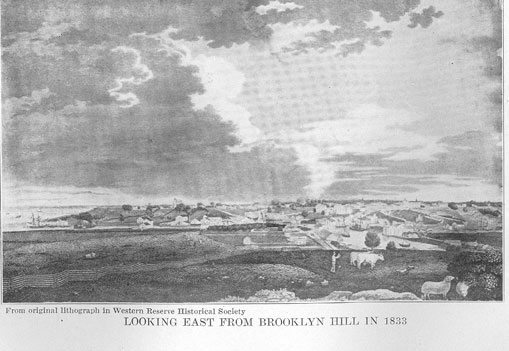
HISTORY OF CLEVELAND - 109
was chosen United States senator. He died September 9, 1896. He was actively identified with
the great railroad and transportation interests of the community.
In 1833 came John A. Foot, a native of New Haven, Connecticut. His father was the governor of Connecticut, and author of the noted Foot Resolution, which brought forth the famous Webster-Hayne debate. A graduate of Yale college, he immediately took rank among the leading lawyers of the town, forming a partnership with Sherlock J. Andrews. He held numerous public offices and was interested in reformatory, educational and philanthropic work. He died July 16, 1891. Thomas Burnham also arrived in 1833. He was a native of Saratoga county, New York, came to Cleveland with a young bride and became a schoolteacher on the west side, in a little schoolhouse on the corner of Washington and Pearl streets. Later he became mayor of Ohio City and was one of the successful business men of the west side.
Milo Hickox arrived in Cleveland from Rochester in 1831. He left a description of that date describing the town : "Cleveland is about two thirds as large as Rochester, on the east side of the river and is the pleasantest sight that you ever saw. The streets are broad and cross each other at right angles. The courthouse is better than the one in Rochester ; the rest of the buildings altogether, are not worth more than four of the best in that place and one room of a middling size rents for one dollar per month. Everything that we want to live upon commands cash and a high price. Mechanics' wages are low. Journeymen get from ten to twenty dollars per month and board ; I get nine shillings and six pence per day and board myself. * * * There are between fifteen and twenty grog shops and they all live. There was one opened here last week by a man fr0m Rochester. There is a temperance society with ten or a dozen male members. The Presbyterian church has four male members, Baptist six, Methodist about the same; the Episcopal is small ; they have a house, the others have not. The courthouse is used at this time for a theatrical company and is well filled with people of all classes. My health has not been good since we have been here. About four weeks since, we awoke in the morning and found ourselves all shaking with the ague. I had but one fit myself. My wife had it about a week every day, and my son three weeks every day, and what made it worse, my wife and son both shook at the same time. I spent one day in search of a girl ; gave up the chase and engaged passage for my wife to Buffalo, to be forwarded to Rochester. She was to leave the next morning. I was telling my troubles to an acquaintance, who told me that he would find a girl for me, or let me have his, rather than have my family leave, so we concluded to stay." (13)
In 1835 James D. Campbell, arrived. He was a distinguished lawyer, occupying many places of public trust, an intimate friend of the leading public men of the day, one of the founders of the Western Reserve Historical Society and a trustee of Case School of Applied Science. He was but a youth when he came to the city and has left us a description of the town as he first saw it : "As the steamer came up the river the boy read the signs on the warehouses : Richard Winslow, Blair & Smith, Foster & Dennison, W. V. Craw, Robert H. Backus, Gillett & Hickox, C. M. Giddings, N. M. Standart, M. B. Scott, Griffith & Stan- dart, Noble H. Merwin ; passed scores of steamers, schooners and canal boats,
13 - "Annals Early Settlers Association," Vol. 3, p. 75.
110 - HISTORY OF CLEVELAND
exchanging wheat and flour from the interior of Ohio for goods and salt to be carried to the canal towns from the lake to the Ohio river. Walking up Superior lane, a steep and unpaved road, you passed the stores of Denker & Borges, Deacon Whittaker's filled with stoves, George Worthington, hardware, at the corner of Union lane, where Captain McCurdy had lately retired from the dry goods business, Strickland & Gaylord, drugs, etc., Stanford & Lott, printing and bookstore, and T. W. Morse, tailor. On reaching the top, Superior street, one hundred and thirty-two feet wide, spread before you-the widest of unpaved streets with not a foot of flag sidewalk except at the foot of Bank street in front of a bank. It was lined with a few brick two and three story buildings. A town pump stood at the corner of Bank street near the old Commercial bank of Lake Erie, on the corner, of which Leonard Case was president and Truman P. Handy, cashier. There were three or four hotels. Dr. Long had a fine two story residence at the corner of Seneca street. Mr. Case, C. M. Giddings, Elijah Bingham, William Lemon, John W. Allen and a few others had residences dotted around the Public Square, on which the Old Stone Church occupied its present site, and in the southwest corner stood the courthouse. The postoffice occupied a ten by fifty foot room in Levi Johnson's building below Bank street and you received your letters from the hands of Postmaster Daniel Worley and paid him the eighteen pence or twenty-five cents postage, to which it was subject, according to the distance it had traveled. The great majority of the best residences were on Water street, St. Clair and Lake streets. A few good houses had been built on Euclid avenue, but the Virginia rail fence still lined it on the north side where Bond street now is, to the Jones residence near Erie street, where Judge Jones and the senator (John P. Jones) lived in their boyhood. There were groves of fine black oaks and chestnuts on Erie street between Superior and Prospect streets and a good many on the northeast part of the Public Square and between St. Clair street and the lake. With its splendid houses, its numerous groves, its lofty outlook upon the lake, its clear atmosphere as yet unpolluted by smoke, Cleveland was as beautiful a village as could be found west of New Haven." "
In 1836 a number of important additions were made to the business, and professional life of the community. Among these are William Bingham, who became one of the leading hardware merchants of the west ; Franklin D. Backus, afterward one of the leaders of the Ohio bar ; D. W. Cross, who practiced law for many years and afterward became a prominent coal operator ; William A. Otis, one of Cleveland's first great iron masters and bankers ; and Charles Brad- burn, a merchant, who devoted much time to educational matters.
From this time forward the development of the city was more certain. Except for the hiatus caused by the great panic of 1o37, the progress of the town was rapid and continuous. The personal era of its history ceased with the swift influx of population, detailed in the succeeding chapter.
The first comprehensive history of Ohio was written by Caleb Atwater in 1o3o. It is a quaint record of the development of the state up to that period and contains the following description of Cleveland : "Cleveland has often been alluded to already in this work and we cannot easily forget so important a town. It has gained its position from its natural advantages and from its intelligent
14 - "Cleveland Leader," February 2, 18g6.
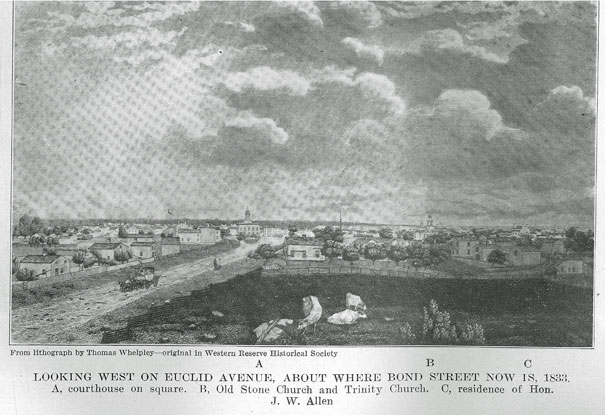
HISTORY OF CLEVELAND - 111
active, wealthy and enterprising population. Taking both sides of the river into view Cleveland contains twelve thousand people, but in 1825 it contained only six hundred. It is delightfully situated on a high sandy bank of Lake Erie, seventy feet above the lake at the mouth of the Cuyahoga river and on both sides of the Erie and Ohio canal. In the summer season, while its port is crowded with its mercantile marine of lake vessels, steamers and canal boats, Cleveland is a busy, bustling city. If we look off on the lake we see many a sail spread to the breeze of this beautiful inland water.
"This town will soon run up to fifty thousand people and forever continue to be an important inland city. The people here have all the elements of prosperity in or near the town ; freestone for buildings, limestone, cedar and gypsum on the lake islands ; iron ore and coal in Tuscarawas county on the canal ; pine forests in Canada across the lake ; water power m abundance in the river and in the canal; and a population as stirring, enterprising and industrious as any in the world." (15)
In 1846 Henry Howe first made his journey through the state and gathered his material for his "Historical Collections." He says of our city : "Excepting a small portion of it on the river it is situated on a gravelly plane, elevated about one hundred feet above the lake, of which it has a most commanding prospect. Some of the common streets are one hundred feet wide and the principal one, Main street, has the extraordinary width of one hundred and thirty-two feet. It is one of the most beautiful towns in the Union and much taste is displayed in the private dwellings and the disposition of shrubbery. The location is dry and healthy and a view of the meanderings of the Cuyahoga river, and of the steamboats and shipping in the port, and of the numerous vessels on the lake under sail, presents a picture exceedingly interesting from the high shore of the lake.
"Near the center of the place is a public square of ten acres, divided into four parts by intersecting streets, well enclosed and shaded with trees. * * *
"The harbor of Cleveland is one of the best on Lake Erie. It is formed by the mouth of the Cuyahoga river and improved by a pier on either side extending four hundred and twenty-five yards into the lake, two hundred feet apart and faced with substantial stone mason work. Cleveland is the great mart of the greatest grain growing state in the Union and it is the Ohio and Erie canals that have made it such, though it exports much by way of the Welland canal to Canada. It has a ready connection with Pittsburg through the Pennsylvania and Ohio canal, which extends from the Ohio canal at Akron to Beaver creek, which enters the Ohio below Pittsburg. The natural advantages of this place are unsurpassed in the West, to which it has large access by the lakes and the Ohio canal. But the Erie canal constitutes the principal source of its vast advantages. Without that great work it would have remained in its former insignificance." *
The Geographers and Gazetteers speak modestly of the town. In t8 1o, "Morses' American Gazetteer" says : "Cleveland is a town in New Connecticut. This town has been regularly laid out and will probably soon become a place
15 - Page 342-3.
* PP. 497-8.
112 - HISTORY OF CLEVELAND
of importance, as the Cuyahoga will furnish the easiest communication bementween Lake Erie and the Ohio; with little expense, a safe harbor may be formed in this town for vessels and boats which trade on the lake. In the compact part of the town were in 1802, ten or twelve homes, and in the whole town about two hundred inhabitants." The "Ohio Gazetteer," of 1817, says : "Cleveland is a commercial post tOWn. It is situated at the mouth of the Cuyahoga river on the southern shore of Lake Erie, and during the late war, it was a considerable depot for provisions and munitions of war, as also a place for building various kinds of boats and other water crafts, for military service on the lake. It is a considerably noted place of embarkation for various ports on the lake."
Thos. L. McKenney, in his "Tour of the Lakes," 1826, says : "Cleveland is a pretty place, which is nested upon a high bluff, and composed of some fifty houses." (16)
CHAPTER XI.
THE GROWTH OF POPULATION.
Whittlesey's Early History, page 456, gives the following table showing the early population of our city:
